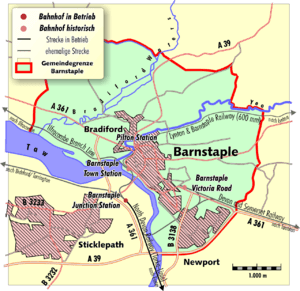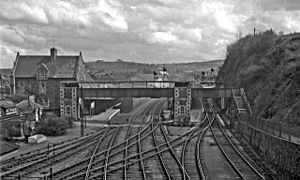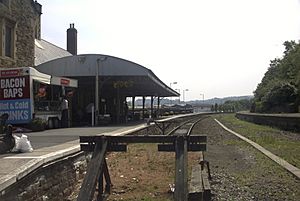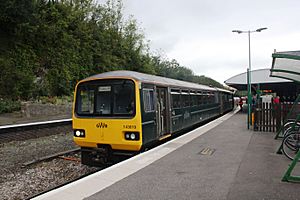Barnstaple railway station facts for kids
Quick facts for kids
|
|
|---|---|
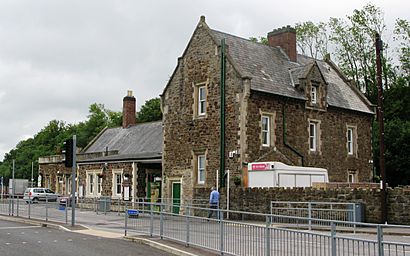 |
|
| Location | Barnstaple, North Devon, Devon England |
| Coordinates | 51°04′26″N 4°03′47″W / 51.074°N 4.063°W |
| Platforms | 1 |
| Other information | |
| Station code | BNP |
| Classification | DfT category E |
| History | |
| Original company | North Devon Railway |
| Pre-grouping | London and South Western Railway |
| Post-grouping | Southern Railway |
| Key dates | |
| 1854 | Opened |
| 1874 | Renamed 'Barnstaple Junction' |
| 1970 | Reverted to 'Barnstaple' |
| Traffic | |
| Passengers (2015/16) | |
| Passengers (2016/17) | |
| Passengers (2017/18) | |
| Passengers (2018/19) | |
| Passengers (2019/20) | |
Barnstaple railway station is the last stop on the Tarka Line. It serves the town of Barnstaple in Devon, England. The station is managed by Great Western Railway. This company also runs all the trains that stop here.
The station is about 211 miles (340 km) from London Waterloo station. It was once called Barnstaple Junction from 1874 to 1970. This was because it was a meeting point for train lines going to different towns. These towns included Ilfracombe, Bideford, Taunton, and Exeter.
Contents
History of Barnstaple Station
The first railway in the area was for goods. It opened in August 1848 from Fremington Quay. On August 1, 1854, the North Devon Railway opened. This line connected Barnstaple to Crediton.
Trains later went further, reaching Bideford in November 1855. This railway line eventually stretched to Okehampton. It passed through Torrington and Halwill Junction. In 1865, the North Devon Railway joined the London and South Western Railway.
Station Expansion and New Lines
The station became bigger and was renamed Barnstaple Junction in July 1874. This happened when the Ilfracombe Branch Line opened. This new line crossed the river on a large bridge. It led to a station called Barnstaple Quay.
Later, in 1898, Barnstaple Quay was replaced by Barnstaple Town. This new station was nearby. It opened when the narrow gauge Lynton and Barnstaple Railway started running. Today, the old Barnstaple Town station building is a school.
In June 1887, a new loop line was added. This connected Barnstaple Junction to the Devon and Somerset Railway. This line was later taken over by the Great Western Railway. The Great Western Railway had its own Barnstaple station, Victoria Road. It opened in November 1873 for trains from Taunton. Barnstaple Junction was made even bigger in 1924.
Changes and Closures
From the mid-1960s, fewer trains used the station. Passenger trains to Torrington stopped running in October 1965. Trains from Victoria Road had moved to Barnstaple Junction in January 1960. The line to Taunton closed in October 1966.
Victoria Road station stayed open for goods trains until March 1970, then it closed completely. The line to Ilfracombe closed in October 1970. After these closures, the station went back to being called simply Barnstaple.
In May 1971, the railway tracks were simplified. The line to Umberleigh became just one track. A new ticket office opened in November 1981. Goods trains on the Fremington line stopped in August 1982. This made Barnstaple station the end of the line.
In 2006, a bridge carrying a main road (A3125) was taken down. This made way for a new road junction for the Barnstaple Western Bypass. The bypass opened in May 2007. A roundabout was built on a raised area. This allows for the railway line to Bideford to reopen in the future if needed. The bypass work also created a larger car park and better bus access at the station. Many local buses now stop at the station.
By March 2009, over a quarter of a million passengers used Barnstaple station each year. In 2009, a report suggested rebuilding the Barnstaple to Bideford line. This would bring train services back to these communities.
Train Engine Shed
The North Devon Railway built a shed for train engines at the station in 1854. The London and South Western Railway built a larger one next to it in 1864. This building was repaired in the 1940s. However, it closed in 1964 and was later pulled down.
Station Cafe
A cafe opened at Barnstaple station in 2008. It was in a part of the station building that was not being used. Just one year later, in 2009, The Guardian newspaper listed it as one of the ten best station cafes.
James May's Toy Stories
In 2009, the old railway line to Bideford was used for a TV show. It was for episode 6 of James May's Toy Stories. The show tried to build the longest model railway ever. They used OO gauge tracks. The model trains only reached Instow before stopping. James May said he chose the spot because he wanted the real line to reopen.
He tried again in 2011. This time, Hornby tracks were laid as a double line. A competition was held between a British team (led by May) and a German team. They raced model trains from Barnstaple to Bideford. All six trains finished the 10-mile journey. The British team won 2-1.
Station Layout and Access
Barnstaple station has one platform. It is on the east side (right) for trains arriving from Exeter. You can easily get to the station car park from the platform. The centre of Barnstaple town is a short walk away. You cross the Long Bridge over the River Taw to reach it.
A footpath from the station leads to a cycle path. This path follows the old railway line to Bideford. It is also part of the South West Coast Path.
There are also tracks for engineers near the end of the line. These tracks allow trains to turn around. There used to be a second platform, but it is no longer used.
Train Services
Barnstaple station has trains running about once an hour. There are seventeen trains on weekdays, eighteen on Saturdays, and thirteen on Sundays. This schedule started in December 2019.
Most trains go to St James' Park. Some trains end their journey at Exeter St Davids or Exeter Central. Most services use Class 158 trains now. These have replaced the older Class 143 trains.
| Preceding station | Following station | |||
|---|---|---|---|---|
| Chapelton | Great Western Railway Tarka Line |
Terminus | ||
| Disused railways | ||||
| Barnstaple Victoria Road Line and station closed |
Great Western Railway Devon and Somerset Railway |
Terminus | ||
| Barnstaple Town Line and station closed |
London & South Western Railway Ilfracombe Branch Line |
Terminus | ||
| Chapelton Line and station open |
London & South Western Railway North Devon Railway |
Fremington Line and station closed |
||
Community Railway
The railway line between Exeter and Barnstaple is a special "community railway". It gets support from the Devon and Cornwall Rail Partnership. This group helps promote the line, which is known as the "Tarka Line".
Three pubs in Barnstaple are part of the Tarka Line rail ale trail. This is a fun way to explore the area by train and visit local pubs.
Images for kids
-
A Class 158 train at Barnstaple, ready to go to Exeter.


